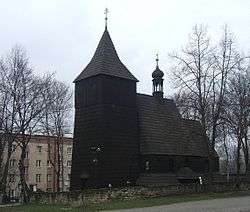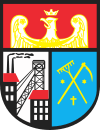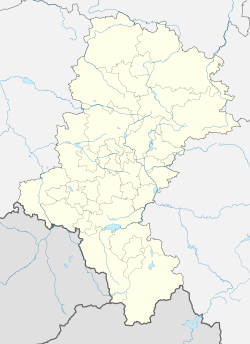Knurów
Knurów ([ˈknuruf]; German: Knurow; Silesian: Knurůw) is a town near Katowice in Silesia, southern Poland. Knurów borders on the Upper Silesian Metropolitan Union, a metropolis with a population of two million.
Knurów | |
|---|---|
 St. Lawrence's Church (16th century). Originally in Knurów, in 1935 the wooden church was moved to Chorzów | |
 Flag  Coat of arms | |
 Knurów  Knurów | |
| Coordinates: 50°13′N 18°41′E | |
| Country | |
| Voivodeship | |
| County | Gliwice |
| Gmina | Knurów (urban gmina) |
| City rights | 1951 |
| Government | |
| • Mayor | Adam Rams |
| Area | |
| • City | 33.95 km2 (13.11 sq mi) |
| Population (2019-06-30[1]) | |
| • City | 38,310 |
| • Density | 1,100/km2 (2,900/sq mi) |
| • Urban | 2,746,000 |
| • Metro | 5,294,000 |
| Time zone | UTC+1 (CET) |
| • Summer (DST) | UTC+2 (CEST) |
| Postal code | 44-190 do 44-196 |
| Car plates | SGL |
| Climate | Dfb |
| Website | http://www.knurow.pl/ |
Knurów is located in the Silesian Highlands, on the Bierawka River, a tributary of the Oder River.
History
Knurów's history as major town is relatively short, as it only became a town in 1951, as result of the merger of the settlements of Krywałd and Szczygłowice. However, Knurów's existence can be traced back as far back as 1295. The original name was Knauersdorf or Cnurowicz, as it emerged as a German settlement during the German resettlement of former Germanic areas during the Middle Ages. As with the rest of Upper Silesia, the town changed hands between the kingdoms of Prussia and Poland over the course of its history. The town rapidly grew at the end of the 18th Century as the Industrial Revolution came and vast coal reserves were found in the area. The coal industry continued growing well in the 20th Century, and doubled its output with a new mine being built in 1961 in Szczygłowice. More recently, in May 2015, riots ensued in the town after a Concordia Knurów fan was shot dead by police during a football match.

Population
Knurów is one of the cities of the 2.7 million conurbation – Katowice urban area and within a greater Silesian metropolitan area populated by about 5,294,000 people.[2] The population of the town is 38,310 (2019).
Politics
Administratively Knurów has been part of the Silesian Voivodeship since the latter's formation in 1999; previously it was part of Katowice Voivodeship.
Economy
The town is usually associated with coal mining, as it lies in the Upper Silesian Coal Basin.
Sport
The town is home to Concordia Knurów, a lower league football club which was founded in 1923, and famously where Jerzy Dudek started his career. Another famous athlete Agnieszka Dubiel, was a professional sailor for many years. She managed to stay in National Sailing Team and represent Poland on many European and World Championships. Her best result was 21st on Youth World Championship 2014.
Twin towns – sister cities


References
- "Population. Size and structure and vital statistics in Poland by territorial divison in 2019. As of 30th June". stat.gov.pl. Statistics Poland. 2019-10-15. Retrieved 2020-02-14.
- European Spatial Planning Observation Network (ESPON) "Archived copy". Archived from the original on 2009-07-28. Retrieved 2009-03-28.CS1 maint: archived copy as title (link)
- "Miasto Partnerskie - Kazincbarcika". knurow.pl (in Polish). Knurów. Retrieved 2020-03-12.
- "Miasto Partnerskie - Svit". knurow.pl (in Polish). Knurów. Retrieved 2020-03-12.
External links
| Wikimedia Commons has media related to Knurów. |
